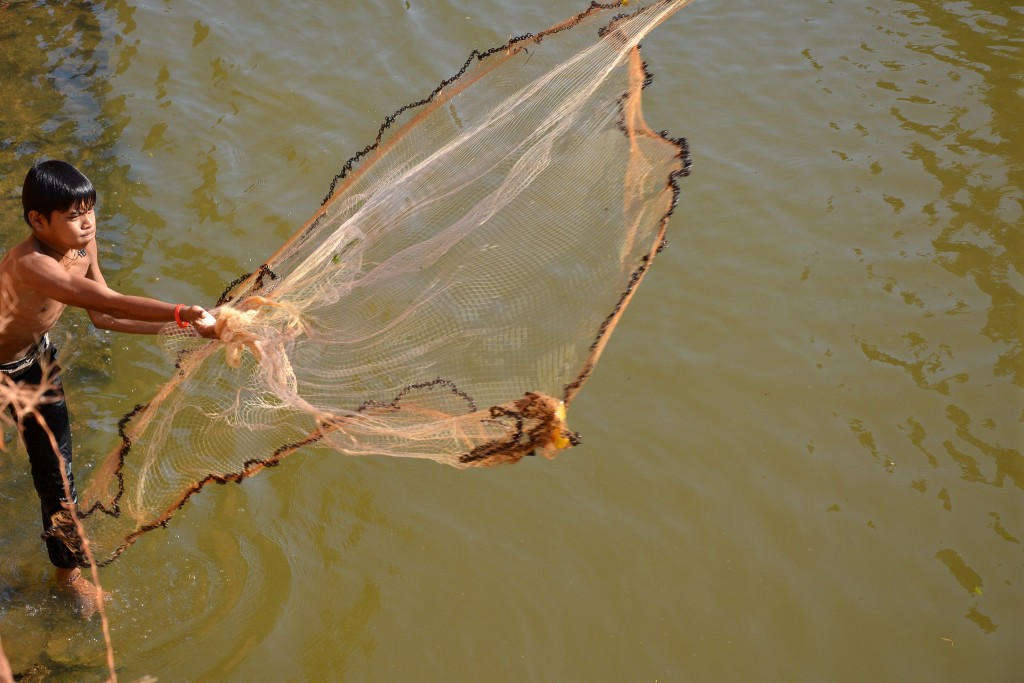
Young man fishing with a cast net on Siem Reap river, Cambodia. Photo by Brian Hoffman, taken on 12 January 2015. Licensed under CC BY-NC-SA 2.0.
Fisheries management in Cambodia is divided between central and local governments. At the central level, the Ministry of Agriculture, Forestry and Fisheries (MAFF) oversees the Fishery sector. Within MAFF, the Fisheries Administration (FiA) is responsible for fisheries research and development, laws and policies and has inspection powers.1
The Strategic Planning Framework for Fisheries 2010-2019 sets out the government’s vision for the sector: “Management, conservation, and development of sustainable fisheries resources to contribute to ensuring people’s food security and to socioeconomic development in order to enhance people’s livelihoods and the nation’s prosperity”.2
Fisheries policy
Ensuring the sustainable management of fish resources and establishing effective trade mechanisms within the fisheries sector is goals encompassed in the National Strategic Plan Update 2014-2018.3
The Strategic Planning Framework for Fisheries 2010–2019 is built around three fundamental pillars: fisheries (marine and inland), aquaculture (marine and inland), post-harvest and trade. The plan aims that by 2019, wild fish capture production is stabilized and sustained at not more than 500,000 tonnes per year; rice field fish production is increased by 15 percent annually, to reach 500,000 tonnes; and aquaculture production is increased by 15 percent annually, to reach 185,000 tonnes per year. The plan also includes targets to eliminate child labor in the fisheries sector.4
Regulatory framework
The enactment of 2006 Fisheries Law represented a positive step towards better fisheries management including the conservation of fish and their natural habitats. The new 125-article law replaces the outdated 1987 Fisheries Law.5
The 2006 Fisheries Law encourages the creation and proper maintenance of conservation area and promotes the development of aquaculture. It also aims to ensure long-term conservation and sustainable management of fishery resources taking into account social, economic and environmental factors. The law ensures local community rights to use fishery resources for traditional, religious and livelihood purposes through the establishment of community fisheries.
The Royal Decree for Community Fishery Establishment and the Sub-decree on Community Fishery Management allows serious penalties to be applied to those who break fisheries law, including government officers. To investigate, prevent and counteract illegal activities and compile documents for submission to the courts, the FiA officers are considered as judicial fisheries police and are tasked with enforcing fisheries regulations.6
The Cambodian Code of Conduct for Responsible Fisheries – known as CamCode, contains guidelines and best practice principles for the use of all stakeholders in the fisheries sector.7
International initiatives
Cambodia is a member of many international treaties and conventions which provide a broad legal framework for fisheries management. These include the Coordinating Body on the Seas of East Asia (1995), MARPOL (1994), Biodiversity Convention (1994), Convention on International Trade in Endangered Species (CITTES) (1997), Ramsar Convention (1999) and the United Nations Framework Convention on Climate Change.8
With respect to regional agreements, Cambodia is a member of the Network of Aquaculture Centres in Asia-Pacific, an intergovernmental organization that promotes rural development through sustainable aquaculture.9
The 1995 Mekong Agreement between Cambodia, Laos, Thailand and Vietnam, codifies many governing principles of international environmental law, and establishes mechanism for cooperation and sustainable development and use of water-related resources including fisheries in the Mekong River Basin.10
With reference to international trade and cooperation regarding fish products and fisheries management, Cambodia is a member of the World Trade Organization, Association of Southeast Asian Nations (ASEAN), which promotes cooperation for the development of aquaculture through the 1983 ASEAN Ministerial Understanding on Fisheries Cooperation and the ASEAN Free Trade Area.11
Last updated: 30 September 2015
Related to fishing policy and administration
- Environment and natural resources policy and administration
- Agriculture and fishing
- Fisheries production
References
- 1. Law on Fisheries Management. 2006.
- 2. “Strategic Planning Framework for Fisheries 2010-2019.” Fisheries Administration. Accessed 1 September 2015. http://www.cdc-crdb.gov.kh/cdc/documents/Sector_Strategy/4_Fisheries/Fisheries_The_Strategic_Planning_Framework_2010_2019.pdf.
- 3. National Strategic Plan Update 2014-2018.
- 4. “Strategic Planning Framework for Fisheries 2010-2019.” Fisheries Administration. Accessed 1 September 2015. http://www.cdc-crdb.gov.kh/cdc/documents/Sector_Strategy/4_Fisheries/Fisheries_The_Strategic_Planning_Framework_2010_2019.pdf.
- 5. “Fisheries and Aquaculture of Cambodia.” FAO. Accessed 1 September 2015. http://www.fao.org/fishery/legalframework/nalo_cambodia/en.
- 6. FAO. National Fishery Sector Overview: Cambodia . 2011. Accessed September 11, 2014. ftp://ftp.fao.org/fi/document/fcp/en/FI_CP_KH.pdf.
- 7. Fisheries Administration. Camcode: Cambodian Code of Conduct for Responsible Fisheries. 2011. Accessed 11 September 2014. http://www.imm.uk.com/DS/Open.aspx?id=a599bb2a-822e-4079-b1cf-fbff69a4f02d.
- 8. Ibid, supra 18
- 9. Agreement on the Network of Aquaculture Centres in Asia-Pacific. 1988. Accessed 11 September 2014. http://www.fao.org/fileadmin/user_upload/legal/docs/021t-e.pdf.
- 10. Mekong Agreement Act 1995.
- 11. “Fisheries and Aquaculture of Cambodia.” FAO. Accessed 1 September 2015. http://www.fao.org/fishery/legalframework/nalo_cambodia/en.

